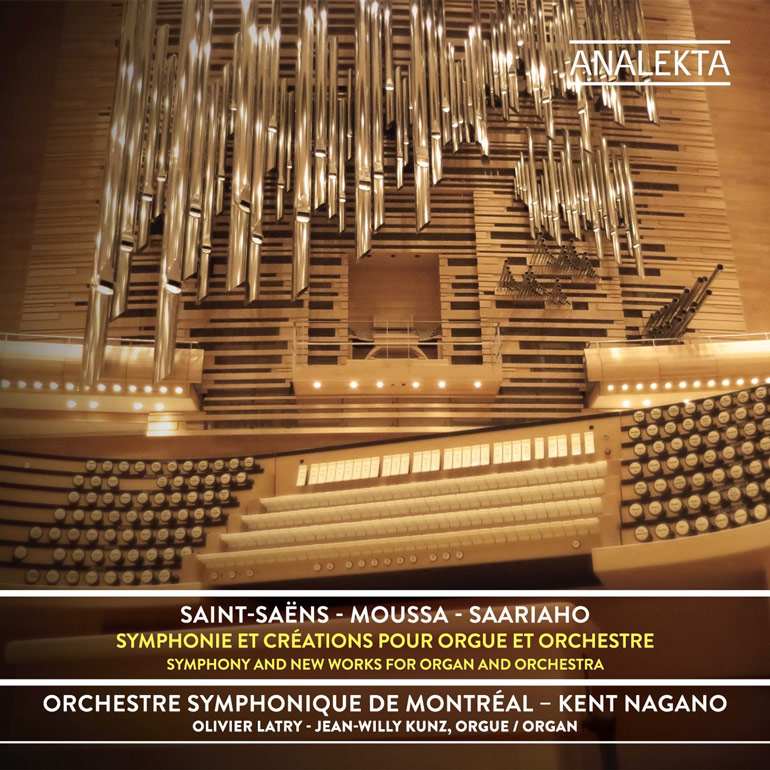
Saint-Saëns/ Samy Moussa/Kaija Saariaho. Olivier Latry & Jean-Willy Kurz (organ). Montreal Symphony Orchestra/Kent Nagano. Analekta. Total Time: 66:07.
The Montreal Symphony Orchestra finally got the first-class concert hall it deserved in September, 2011, but it wasn’t until three years later that the new organ was up and running in Maison symphonique. To celebrate the occasion, the MSO presented an inaugural concert for the Grand Organ “Pierre Béique” on May 28, 2014. The Saint-Saëns Organ Symphony was the centerpiece of the concert, but new works for organ and orchestra by Canadian composer Samy Moussa and Finnish composer Kaija Saariaho were also included.
Named for the MSO’s founder and longtime general manager Pierre Béique, the new organ is said to have been designed and built by “ Casavant with the collaboration of architects Diamond Schmitt + AEdifica for its visual design.” For the record, Casavant is a famous organ builder based in Saint-Hyacinthe, Quebec. There seems, however, to be some dispute about who actually designed this instrument, particularly concerning the placement of the pipes and console, and the extremely imaginative look of the entire organ set-up on the wall behind the orchestra. According to an article in the Montreal Gazette, credit should be given to either Didier Grassin, a Casavant employee at the time the instrument was built or to architect Jack Diamond – but that is a mystery to be solved another day.
The Grand Organ Pierre Béique has 83 stops, 116 ranks, and 6,489 pipes. Jean-Willy Kunz, the MSO’s Organist in Residence, is featured in the Moussa piece on this CD, while Olivier Latry, the renowned organist at Notre-Dame in Paris and also the MSO’s Organist Emeritus, is organ soloist for the Saint-Saëns and Saariaho works.
A few years back I heard a wonderful – if physically challenging – performance of the Saint-Saëns by the MSO under its former music director Zubin Mehta, at the Notre-Dame Basilica in old Montreal. The orchestra was on floor level at one end of the cathedral, and the organist was in a loft at the other end of the building. Given the long reverberation time, it was an amazing feat for Mehta and the musicians to be so well synchronized with the organ.
Maison symphonique poses no such physical challenge since the organ is located right behind the orchestra. Unfortunately, Analekta chose to provide no photos of either the organ or its location in Maison symphonique, other than the inadequate CD booklet cover shot. To fully appreciate the visual beauty of the organ and its integration into the hall, do a google search of “Grand Organ Pierre Béique” and click on “images.”
The problem for any composer writing for organ and orchestra is that the former can so easily overwhelm the latter to the point where even the largest orchestra can be made to sound puny and irrelevant. Saint-Saens cleverly solves this problem in his Organ Symphony by holding back the full force of the organ until the last movement. The organ doesn’t play at all in the first movement, and in the second movement, poco Adagio, it is never allowed to play louder than pianissimo.
Whatever conductor Kent Nagano does, he does with taste and transparency. That is certainly the case with the Organ Symphony. For example, he takes great care to ensure that the piano parts come through with maximum clarity. At the end of the piece, when the organ is finally allowed to cut loose, it makes a glorious sound. That said, there is a restraint in Nagano’s conducting that undermines some of the most compelling features of the symphony. The trumpets, for example, are almost inaudible throughout. For comparison, listen to the legendary 1959 recording by Charles Munch and the Boston Symphony (RCA Victor 61387). Munch was never noted for his restraint and in that 1959 recording, he inspired his orchestra to go all out. What a performance!
Neither of the contemporary composers’ works presented on this CD avoid the problem I mentioned earlier – preventing the organ from flattening the orchestra. Samy Moussa, born in Montreal, now lives in Berlin. A Globe Itself Unfolding was commissioned by the MSO, and this was its first performance. Based on slowly changing chords, it ends with a massive crescendo. In this piece, the organ is used less as a solo instrument and more as a helpful generator of an enormous weight of sound. The MSO musicians must have been cowering in fear when the organ let loose. I can’t say I found the piece particularly engrossing.
Kaija Saariaho’s Maan Varjot was also commissioned by the MSO for this occasion. Although she insists in her notes on the piece that this is not an organ concerto, the organ clearly gets to have most of the fun. The orchestra, when it can be heard at all, seems to provide little more than embellishment. Such is Saariaho’s ear for sound, however, that she gets a vast range of colours and textures out of the organ. The audience at Maison symphonique must have been amazed at what they heard. But again, one has to sympathize with the MSO musicians as they soldier on in the face of an onslaught of sound that threatens to obliterate everything they are asked to do.
Montreal Symphony Orchestra/Saint-Saëns, Moussa & Saariaho is available for purchase via Amazon.ca.
#LUDWIGVAN
Want more updates on Toronto-centric classical music news and review before anyone else finds out? Get our exclusive newsletter here and follow us on Facebook for all the latest.
- SCRUTINY | TSO Lets Berlioz Do The Talking In Season Opener - September 21, 2018
- RECORD KEEPING | Even Yannick Nézet-Séguin Can’t Make Us Love Mozart’s La Clemenza di Tito - September 6, 2018
- RECORD KEEPING | Giovanna d’Arco With Anna Netrebko Explains Why The Best Operas Survive - August 30, 2018



